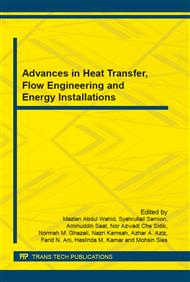[1]
R. G. Prucka, Z. S. Filipi, and D. N. Assanis, Control-oriented model-based ignition timing prediction for high-degrees-of-freedom spark ignition engines, J. Automob. Eng., vol. 226, no. 6, p.828–839, Mar. (2012).
DOI: 10.1177/0954407011430178
Google Scholar
[2]
N. Kara Togun and S. Baysec, Prediction of torque and specific fuel consumption of a gasoline engine by using artificial neural networks, Appl. Energy, vol. 87, no. 1, p.349–355, Jan. (2010).
DOI: 10.1016/j.apenergy.2009.08.016
Google Scholar
[3]
X. Zhen, Y. Wang, S. Xu, Y. Zhu, C. Tao, T. Xu, and M. Song, The engine knock analysis – An overview, Appl. Energy, vol. 92, p.628–636, (2012).
DOI: 10.1016/j.apenergy.2011.11.079
Google Scholar
[4]
J. Vasu, A. K. Deb, and S. Mukhopadhyay, Development of SI-Engine based Extended MVEMs for use in Estimators for Engine Health Management, SAE Tech. Pap. Ser., (2012).
DOI: 10.4271/2012-01-1990
Google Scholar
[5]
M. Abu-qudais, Exhaust Gas Temperature for Knock Detection and Control in Spark Ignition Engine, Energy Convers. Mgmt, vol. 37, no. 9, p.1383–1392, (1996).
DOI: 10.1016/0196-8904(95)00221-9
Google Scholar
[6]
E. Ollivier, J. Bellettre, and M. Tazerout, PAPER SERIES A Non Intrusive Method for Knock Detection Based on the Exhaust Gas Temperature, SAE Tech. Pap. Ser., vol. 2005–01–11, (2005).
DOI: 10.4271/2005-01-1129
Google Scholar
[7]
E. Ollivier, J. Bellettre, M. Tazerout, and G. C. Roy, Detection of knock occurrence in a gas SI engine from a heat transfer analysis, Energy Convers. Manag., vol. 47, no. 7–8, p.879–893, May (2006).
DOI: 10.1016/j.enconman.2005.06.019
Google Scholar
[8]
J. B. Heywood, Internal Combustion Engine Fundamental, vol. 21. McGraw-Hill, (1988).
Google Scholar
[9]
M. S. Radwan, A. H. B. Helali, S. M. Elfeky, and Y. A. Attai, An Investigation on Knock and Pre-ignition with Tumble Induced Turbulence, SAE Tech. Pap. Ser., vol. 2007–01–35, (2007).
DOI: 10.4271/2007-01-3557
Google Scholar
[10]
S. D. Hires, R. J. Tabaczynski, and J. M. Novak, The Prediction of Ignition Delay and Combustion Intervals for a Homogeneous Charge , Spark Ignition Engine, p.1053–1067, (1978).
DOI: 10.4271/780232
Google Scholar
[11]
N. C. Blizard and J. C. Keck, Experimental and Theoretical Investigation of Turbulent Burning Model for Internal Combustion Engines, p.846–864, (1974).
DOI: 10.4271/740191
Google Scholar
[12]
T. Morel, C. I. Rackmil, R. Keribar, and M. J. Jennings, Model for Heat Transfer and Combustion in Spark Ignited Engines and Its Comparison with Experiments, (1988).
DOI: 10.4271/880198
Google Scholar
[13]
A. M. Douaud and P. Eyzat, Four-Octane-Number Method for Predicting the Anti-Knock Behavior of Fuels and Engines, SAE Tech. Pap. Ser., no. 780080, p.294–308, (1978).
DOI: 10.4271/780080
Google Scholar


